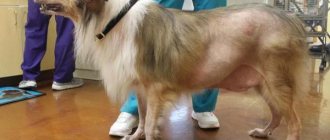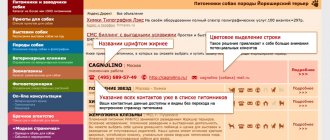Do you want to adopt the smallest and most touchingly skinny puppy in the litter and give him all your love? This is wonderful, you are probably a very good person with a kind heart. Unfortunately, not a single breeder in the world, selling you such a puppy, will say that in this case it would be good for you to have an additional hundred thousand in your account. They will be needed for the foreseeable future.
Today we will talk about portosystemic shunts (PSS). About what? Don't switch, I'll tell you more in simple words. If you have never heard of this disease, this is absolutely normal; unfortunately, some veterinarians do not know about it either.
A little bit about anatomy
I’ll explain it as primitively as possible.
This is what a dog's liver looks like. Don’t be intimidated by the complex terms in the picture, let’s break through.
As you remember from your school biology course, the liver has many, many functions, one of which is the detoxification of metabolic products. This means that if there are toxins in the blood, then after passing through the liver (and the vascular bed of a healthy dog will sooner or later deliver blood to the liver), they will be neutralized there and will not be able to cause harm. For example, in the liver, ammonia is converted into urea, which is then excreted in the urine by the kidneys.
Health issue.
First of all, it is important to choose a healthy puppy. The coat should be clean, including under the tail and in the genital area, shiny and without dandruff. The smell is specific, reminiscent of milk. In males, by 2 months the testes descend into the scrotum and can be easily palpated. The claws should be neat and not brittle. Ears are clean. The whites of the eyes are white and the conjunctiva is pink. The nose is clean and moist. Bleeding or crusting indicates problems. There should be no unpleasant odor coming from the mouth, the tongue is clean without plaque, the teeth are sharp, white, the gums are moist and not swollen. The bite depends on the breed and is prescribed in the standard, usually scissor-shaped. Movements should be confident, perhaps a little awkward, but without a hint of stiffness. The baby should be at the optimal weight for his age. The joints are not enlarged. The ribs are felt. The presence of nodules on them indicates the onset of rickets.
Most breeds have characteristic hereditary diseases. Genetic tests and x-rays for dysplasia in parents make it possible to exclude sick dogs from breeding and increase the likelihood of having healthy offspring.
What is a shunt?
Look carefully at the drawing again. Do you see two vessels shown in blue: the caudal vena cava and the portal vein of the liver ? Through the portal vein, blood from the stomach and intestines COMES to the liver, and through the caudal vena cava, “clean” blood without toxins COMES OUT of the liver. That is, one vessel enters the liver and one vessel exits the liver. There is no other option.
What is PSS? This is a vessel between these two veins, through which part of the blood bypasses the liver, bypassing all the complex processes of detoxification. Do you understand? Some of the blood is not freed from toxins and continues to move further throughout the body.
PSS is a bad, very bad abnormal vessel in which some of the blood bypasses the liver and is not cleared of toxins. Blood with toxins continues to flow through the arteries and veins of the little puppy, poisoning his life.
Meet the puppies and breeder. The issue of vaccination, branding and microchipping.
The conditions in which the dogs are kept and the appearance of the mother of the family will tell a lot. A good breeder not only answers questions, but also asks them himself; he wants the baby to end up only in good hands. He knows the character of his charges and will tell you which puppy to choose. He considers vaccination a mandatory procedure, and not a way to attract a buyer and increase the price of a puppy. The presence of a microchip, much less a brand, does not entice you.
At the age of 3 weeks, puppies are wormed for the first time, at 8 weeks they are vaccinated against major infectious diseases and given a veterinary passport, in which notes are made about everything related to health. Confirmation of vaccination will be a sticker with the name of the vaccine and serial number, certified by the seal and signature of the doctor. The only way. A baby vaccinated according to standard schemes can already fully walk and communicate with his brothers at 2.5-3 months. Otherwise, you will have to deal with this issue yourself, observe quarantine and use a diaper at home for at least a month.
The mark is placed on any purebred dog at 45 days, during activation (examination by a dog handler) for the issuance of a metric (puppy card, which is exchanged for a pedigree). The mark is usually tattooed on the ear or inner thigh and consists of 3 letters and numbers identifying the litter. This number is recorded in the metric and then in the pedigree.
A microchip is proof that an animal belongs to a specific person in case of theft. This is a microcircuit that is inserted under the skin, usually in the withers area. It is performed in most clinics at any age. Each chip has an individual number, which is read by a special scanner; it is recorded in the veterinary passport and entered into a common electronic database along with the owner’s data.
How will this manifest itself?
The symptoms of PSS can be mysterious, even to veterinarians. Most often, these are small, developmentally delayed puppies and kittens with a calm temperament. They may have periodic gastrointestinal disorders, and their health may worsen after feeding. Most often, such patients are admitted with encephalopathy (toxic brain damage) - the dog loses coordination, cannot find a place for itself, rests its head against the wall, bumps into objects, and staggers.
In this video, a Maltese dog has symptoms of encephalopathy due to the presence of a shunt. Be careful, this video may upset sensitive people.
Of course, small size and quiet character are not a 100% indicator that the puppy is sick. But it makes me wary.
Appearance and compliance with the standard.
You need to understand that a breed is not only about pedigree and the need to participate in exhibitions, it is also about character, care characteristics and appropriate appearance. The puppy may not have documents, but compliance with the standard indicates its purebred origin. At the age of 1.5-2 months, the bite, ear set, position, color, pigmentation of the nose, claws and other signs must meet the standard.
A personal question is how to choose a puppy for exhibitions. The standard describes the ideal adult dog. The puppy is far from fully responding to him. Without experience, you cannot do without the help of an expert dog handler.
Let's talk about money. Where does RUR 100,000 come from?
If you opened this article from Twitter, then you were probably somewhat surprised by this number. Of course, this is an approximate cost. It all depends on the city, clinic, patient size and other factors. But on average, the diagnosis, surgical treatment and placement in the intensive care unit of a puppy with this disease costs this amount.
If surgery is not performed, the dog's quality of life will be poor and he may die during an epileptic seizure caused by the effects of toxins on the brain.
Tips for purchasing a puppy
If you want to buy a purebred puppy, and also to avoid becoming a victim of scammers, you should not buy puppies through advertisements on the Internet or on zoological markets, or from unverified breeders. Even the documents provided for the puppy, confirming its pedigree, may, unfortunately, turn out to be fake.
How to avoid becoming a victim of scammers
Having chosen a fashionable or rare breed, you must understand that the cost of a puppy of such a dog will be considerable, taking into account the costs of maintaining the mother, mating, giving birth and raising the puppy. If you are offered a puppy of this breed for a price that is significantly lower than usual, then you should know that they are trying to deceive you.
Pet business. The low cost of purebred dog puppies can be explained by the unscrupulous and irresponsible attitude of the breeder (the dogs of such breeders can even be registered in a kennel club, but their pets are unlikely to take prizes and the club will not recommend them for purchase and breeding). The explanation is simple: dogs for them are not faithful companions and pride, but a source of income.
Such breeders save on the maintenance and nutrition of their dogs; they breed them 2-3 times a year, which is extremely harmful to the health of their pets (hormonal drugs are often used for this).
Photo: Jeff Slinker
Bulldog/Rhino mix. The most common scam when selling puppies at poultry markets and over the Internet is the sale of mixed breeds under the guise of purebred puppies.
Such dogs are usually sold at a fairly early age (1-1.5 months), when the lack of breeding is imperceptible to the inexperienced eye and the puppy can be passed off as a specific breed, to which it is similar in color. Video about a scammer selling outbred puppies under the guise of purebred ones
Often such dogs grow up to be completely different in appearance from the given breed, and they can also differ greatly in size.
Photo: Ana C.
Zamoryshi. Another danger of purchasing a puppy from an unverified seller is diseases.
As a rule, such sellers will not tell you the true state of health of the mother and litter, the conditions of their maintenance and feeding. And most often, puppies are collected from different litters and kept crowded together, literally without the ability to move freely, without any necessary treatments (mandatory deworming and vaccination, treatment if necessary). At the market, they spend the whole day in a cramped box in any weather - both hot and cold. Nutrition, as a rule, is insufficient and poor in essential nutrients. Therefore, often puppies purchased in markets and through advertisements are either already sick (not excluding hereditary diseases), or weak and extremely susceptible to diseases. It is not always possible to save the life of such an animal. Sick puppies will cause a lot of trouble and suffering to their owners, not to mention the considerable financial costs of trying to cure the pet, because many chronic diseases acquired in childhood can manifest themselves throughout the dog’s life.
Breeders won't tell you about this
While I was writing this article, questions began to flash in the comments: “So what now, drown these puppies?”, “Isn’t the smallest puppy worthy of a happy life?” etc. No, friends, of course, such puppies should also have loving owners and a happy life (after surgery).
Unscrupulous breeders will not tell about this. They will try to sell a puppy like a "Minika" as a "teacup" version of your favorite breed. Therefore, it will be great if people understand ADVANCE what problems they may face in the future when buying the weakest puppy with the potential risk of having PSS. If such a puppy ends up with people who cannot even afford blood tests for diagnosis, then his entire life will pass through a veil of encephalopathy. This is a bad quality of life.
Which puppy is better in the litter?
You have to choose a puppy. What should you pay attention to? How to choose the right puppy in the litter? Which puppy is better?
Breeder and litter.
First of all, you need to decide on the breeder, that is, the owner of the bitch. Today there are a large number of nurseries for various breeds. All nurseries are registered in the RKF, many have their own website. Therefore, it is not difficult to find out about the availability of puppies and their date of birth. View photos of the parents of this litter and their pedigrees. Find out about their achievements at exhibitions and performance tests. You can look at the already grown puppies of these dogs from previous litters.
Buying a four-legged pet is an interesting, but very important moment. All future owners want to quickly bring this day closer and take the puppy home. However, before going to a pet store or breeder, you need to know some recommendations. Which will help you choose not only a beautiful and faithful friend, but also a healthy animal.
At what age should you choose a puppy and pick it up?
This question puts most people planning to get a dog in a stupor. “Is it really that important?” - this is the answer of the overwhelming majority. Unfortunately, too early or too old a dog can lead to big problems in the future. Virus, colds, serious genetic diseases, inability to adapt, aggression, lack of contact with new owners... These are only a small part of the problems that can be detected due to the wrong time of purchasing a puppy. And yet - the most favorable period for socialization in a new family. This will greatly affect the dog’s education in the future.
Period from 0 to 8 weeks.
This age is considered the most “tender”. The dogs are just getting used to this world, getting to know their mother and other puppies in the litter, actively growing, and gaining weight. For the first two weeks they are blind and partially deaf. Their immunity is poorly developed. By taking home such a small puppy, the owner risks the health of his four-legged friend. Up to 3-4 weeks, dogs, like babies, “take advantage” of the mother’s immunity, and if they are separated at this time, the baby will very easily catch a virus or cold. During this period, the most careful care of the puppy should be provided.
In addition to all of the above, at this age it is impossible to determine the purebred of a puppy. If a person takes a dog for exhibitions or breeding, then at this age he will not be able to understand its breeding qualities. It is also impossible to determine the correctness of the bite, since the teeth have not yet grown. During these eight weeks, breeders try to accustom the litter to a diaper, adapt them to people, introduce them to toys, and give them the first vaccination. If you take a puppy before it acquires all these skills, then the new owners risk getting an unadapted, “wild” dog. Which puppy is better is very difficult to determine at this age.
Period from 8 to 16 weeks.
This is the most suitable age for meeting new people, learning the basics of behavior and, accordingly, for moving to a new home. If the dog has any defects, then by this time they will already appear, and buyers will be able to decide whether these problems are critical or not. From 8 weeks, the breeder is usually ready to transfer the puppy to a new family. When choosing a puppy from a litter, try to be admitted to them early. While the entire litter is not sold out yet and you have some choice. By comparing them to each other, it will be easier for you to determine which puppy is better in the litter. And a conscientious breeder should help you do this.
Or maybe you are planning to buy a puppy to develop some working qualities. Then it’s time to pick him up and start training him immediately after the first vaccinations.
Period from 16 weeks and above.
At the age of 4-5 months, the period of easy training and retraining of the puppy ends. By this time, he already has a clearly formed set of norms and habits. If the breeder treated the dog's upbringing carefully and conscientiously, then the adult dog will not bring unpleasant surprises to its new owners.
If you are taking a dog for your home, for your soul, then it is not at all necessary to take a puppy from famous champions. Moreover, their price is much higher. If you need a dog for service or sport, then you should pay attention to diplomas on the working qualities of the parents. If a person is aiming to buy a “show” dog, then choosing a puppy should be approached more than responsibly. Studying breed standards, possible defects in appearance, common diseases are very important steps in preparing for a purchase. And, of course, if you plan to attend exhibitions, you will need a show-class puppy. Then you should also take into account the exhibition achievements of his parents.
Health assessment - which puppy is better.
If the dog is purchased primarily as a friend, a family member, then no problems with appearance can be a problem. But checking her health remains important. Here it is important to pay attention to appearance. The correctness and proportionality of the physique should be assessed. The fur should be shiny, the health of the puppy should not be in doubt, the nose should not be dry, cool, and the eyes should not be watery. You can also look at the puppy’s excrement and feel its bones. Choosing the right puppy is a crucial moment. After all, no one wants to have an unhealthy baby and with it the problems of treatment and more difficult adaptation to a new home.
Choosing a puppy based on behavior.
An apparently healthy puppy's correct reaction to a stranger is curiosity. The puppy does not show any desire to run away from you or evade your hand. And falling on your back in front of you is also an undesirable sign. This may indicate possible timidity or even cowardice in the future. At the age of two months, a puppy should not be afraid of humans at all.
But growling and showing teeth is also unacceptable. Such a puppy can grow into a leader who constantly fights with you for primacy. It's good if the puppy wants to play with you. However, if he sniffs you calmly and friendly and returns to his business, that’s also not bad at all.
A lively, healthy puppy is always active at this age. He competes for a bowl or his mother's nipple, eats greedily, immediately plays actively after eating, fusses with his brothers and sisters, and after playing enough, sleeps for a long time and soundly. You definitely need to pay attention to how the puppy moves and whether the placement of its paws is correct. And he should not limp or drag his paws. But what is also very important is that the chosen puppy should arouse your sympathy. When purchasing a puppy, people are not buying a toy, but a living creature. It is very important that a connection is established between the owner and the four-legged friend, otherwise no parenting advice will help.
Test. Which puppy is better?
Males.
Males: they have clearly expressed features of the breed, both in appearance and in character. Choosing a puppy over a male has its own characteristics. So, males are more independent, straight, and simple-minded. And they are less affectionate and affectionate than females. Activity is very important for male dogs. They are fascinated by the process itself. And it doesn’t matter what you do: training, playing, guarding or hunting.
Males are more aggressive than females. And this also comes from the fact that their social position is very important to them. They mark their territory, sniff each other, showing their superiority. And the more expansive the opponent behaves, the higher the aggressiveness of the dog. Often a male dog, especially a leader prone to aggression, can be more difficult to control. They require tougher and more persistent training methods. They tend to run after bitches in heat. Therefore, it is necessary to develop unquestioning obedience.
Bitches.
Bitches: they are more affectionate to their owner. They appreciate affection and are more obedient. Bitches are attentive and focused at work. They show more caution and flexibility. But in acute situations they show all the strength of their character, intelligence, cunning, and fearlessness. Therefore, choosing a puppy over a bitch is often more suitable for women who are less tough in character.
A certain inconvenience to the owner is caused by estrus, which occurs 2 times a year. In this state, bitches are much more sociable and tend to flirt with oncoming males. During such periods, you must walk only on a leash and avoid places where dogs gather. Also, training a female dog is often easier than training a male dog. Although not always.
It would also not be superfluous to pay attention to the original documents, if available: puppy birth certificate, pedigree of the parents, inquire about the first vaccinations and anthelmintic measures performed. But these are different questions that require different competence.
Which puppy is better? You decide. But we need to approach this issue carefully and comprehensively.
Cynologist instructor Yagovitina Yu.A.
Documentation
Why does my puppy need a passport, I’m taking it “for myself”? It’s hard to imagine a stranger phrase. It is clear that for yourself, and then for someone else. But even mongrel puppies, or representatives of the pet class who do not participate in breeding, must have a passport confirming the presence of preventive vaccinations.
Taking on an unvaccinated puppy is quite risky. If a baby contracts a viral infection, it will almost inevitably die. What a shock this death is for families in which the dog was intended for children. And if a purebred baby cost tens of thousands of rubles (which is not uncommon in our time), then human grief is joined by regret about wasted money. All this can be avoided if you adopt a puppy not at 2 months, but at 3 months and older, already vaccinated.
The Zootopia channel wishes health to you and your pets!
Features of the breed and pricing
For those who are just beginning their acquaintance with Yorkies, you should understand the varieties of this breed. There are three classes of puppies:
- Show is a representative of the highest class, with an excellent exterior and good prerequisites for first places in competitions.
- Breeder – puppies of this group have minor flaws, which are quite acceptable for this breed. An older dog is not the best representative at shows, but it is capable of producing excellent offspring.
- Pet – this class does not take part in exhibitions and breeding work. However, such puppies are often purchased by those who just need a pet.
Yorkies are loved for their cheerful disposition, terrier-like courage and miniature size.
Attention! The cost of a dog directly depends on the class. Thus, the price tag for first class can be quite high and not affordable for everyone, but third class Yorkies are quite affordable. These are the puppies you can buy in pet stores.
In addition to whether a puppy belongs to one group or another, its cost is influenced by a number of factors:
- parents' pedigree;
- puppy card;
- quality and uniformity of litter;
- natural qualities of the puppy (appearance, disposition, individual characteristics);
- gender (girls are usually more expensive).
Gender selection
After the stage of choosing the breed of the puppy, you will need to decide on the gender of the future pet. If you fundamentally want to have only a male or female for the purpose of further breeding, then the issue is resolved for you.
For those who are still choosing the gender of the puppy, the following information will be useful. Usually, males and females have some differences in character and appearance.
Features of males:
- usually look larger than females, more powerful and muscular;
- have a strong nervous system, therefore they are more resilient than individuals of the opposite sex;
- due to their physiological characteristics, they are able to work all year round, unlike bitches who are less productive during the period of heat.
Disadvantages of male dogs:
- have a more aggressive and dominant character in relation to relatives and the owner. If you do not pay due attention to training in time, they can become uncontrollable;
- less attached to the owner than bitches;
- in the presence of “girls” they behave uncontrollably. They can drop everything when they hear the smell of a leaking bitch. Therefore, when going for a walk with a dog, you must take a collar and leash with you;
- have a need to mark their territory wherever they are. Thus, walking with a male dog takes longer than with a dog of the opposite sex.
IMPORTANT! When the puppy grows up and begins to show attention to “girls”, you need to decide: will you seriously engage in breeding offspring or not? If the answer is negative, it is better to castrate the male dog, which will help to avoid problems with the dog’s behavior in the future. It will also significantly reduce the risk of cancer in your dog.
Features of bitches:
- usually have smaller sizes than males, look smaller and squat;
- more attached to the owner and home;
- have a soft, flexible character and are easy to train;
- They have high intelligence, unlike male dogs, who are more emotional.
Disadvantages of bitches:
- not as hardy as males;
- bitches go into heat several times a year. During this period, the dog becomes less efficient and may not obey the owner;
- during an accidental mating, she can become pregnant and bring unwanted puppies into the house;
- During pregnancy and nursing puppies, she becomes less active and unfit for service.
For breeding dogs, it is better to take a female dog, because raising an “extra-class” male is very difficult.
IMPORTANT ! If you do not intend to use the bitch for breeding, it is better to sterilize her to avoid health problems.
Having become familiar with the characteristics and disadvantages of both sexes, it will be easier for you to make a choice in favor of one or the other.
Appearance
Having chosen the puppy you like from several offered, you should pick it up and carefully examine it. It is necessary to rely on the following criteria:
- strong physique, cheerful disposition and playfulness;
- clean, shiny, smooth coat;
- black, cold and wet nose, without discharge or crusts;
- straight limbs and rounded, collected paws;
- bright pink mouth color;
- straight or scissor bite, 6 incisors and 2 canines on each jaw;
- clean ears, with even covering;
- uniform and free breathing;
- smooth and clean abdominal skin.
The following characteristics should be alarming symptoms:
- dandruff, flaking or dry skin;
- nasal discharge, crusting;
- stooped back;
- incorrect bite (such a dog cannot be used for breeding);
- open fontanel in 2-3 month old babies (for those who apply for participation in exhibitions). Checked by carefully feeling the crown of the head;
- a large head, combined with a fragile body, may be a symptom of a brain disease that causes the dog’s early death;
- smudges under the eyes, inflammation, inclusions or spots on the iris;
- the puppy shakes its head and scratches its ears;
- dirty ear canal, “bald patches” or crusts on the ears, unpleasant odor;
- bloated abdomen, presence of protrusions;
- glued hairs in the genital area, indicating the presence of inflammation;
- undescended testes near cables.
The breeding value of Yorkies is also assessed by the color of the dog. Before the age of 15-18 months, it is difficult to predict the color of his coat in the future. Parents and grown puppies from their previous litters can serve as a guide. The seller’s statements that the puppy will grow from silver to steel is a reason to doubt the veracity of such a seller.
Choosing a Yorkshire Terrier pet is a very labor-intensive task. However, by carefully studying the characteristics of the breed, understanding the nuances and evaluation criteria, you can purchase an excellent puppy, both for participation in exhibitions and as a pet.
Before meeting the puppy
If there is such an opportunity, you need to look at both parents of the cub. It is especially important what the mother looks like. It is necessary to evaluate whether her coat is shiny and whether she has lost a lot of weight while breastfeeding her babies. If in front of you is an unfortunate emaciated creature with watery eyes, then it is obvious that the offspring did not have enough nutrients. Character is also important. A calm, balanced female will not rush at the owner who is showing the precious puppies to a stranger.
There should not be a strong smell of ammonia in the house; you can ask to show what the dogs are fed and in what conditions they are kept.
Behavior and character
When choosing a Yorkie, it is important to see his parents, because all babies are similar to each other. Having the opportunity to see mom and dad, you can draw conclusions about the “purity” of the breed and the key qualities of the puppy.
It is also important to observe the baby’s behavior when surrounded by brothers and sisters. This way you can evaluate temperament and disposition. Each litter has its own leader, who is more active than other representatives and involves them in his game. This puppy is ideal for families with small children. If the puppy is not very active or is away from its brothers, then this may indicate both an illness and a calm temperament of the puppy. This type is suitable for measured people.
A well-known temperament test is to turn the puppy over on its back and hold it in that position for half a minute. This position will force the baby to show character. The one prone to aggression will begin to bite, the cheerful one will start playing, and the shy and cowardly one will cower and wait for the end of the “execution.”
When buying a puppy, carefully read its pedigree










